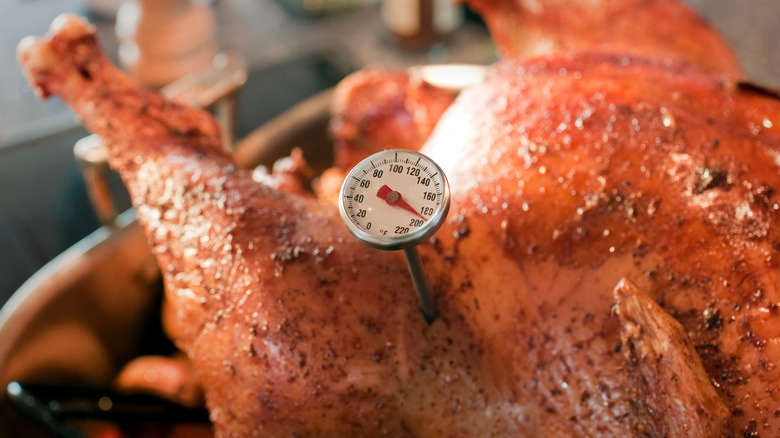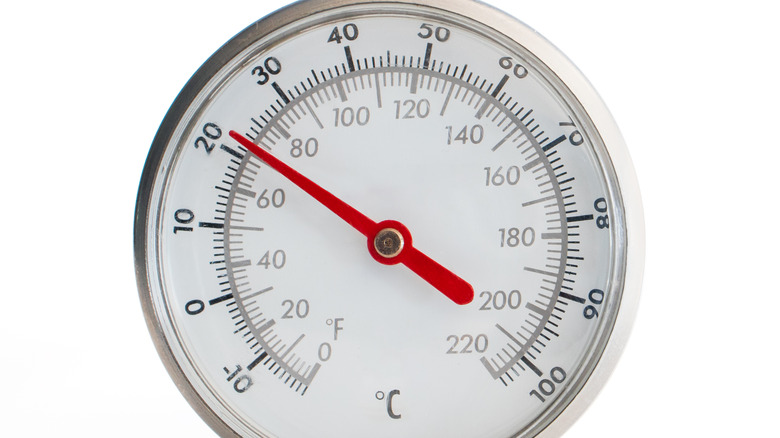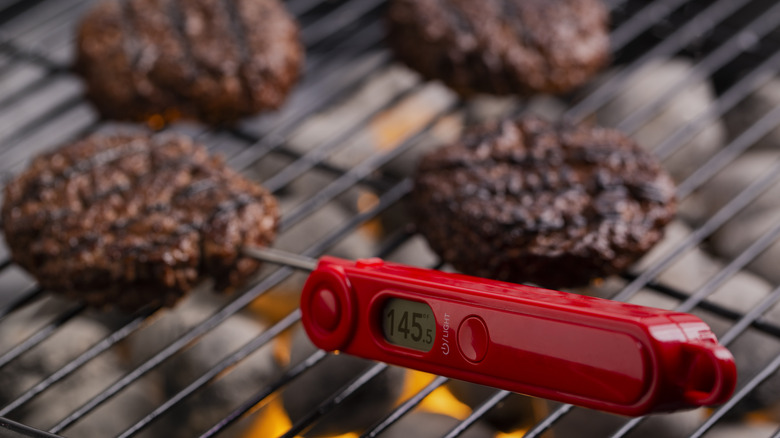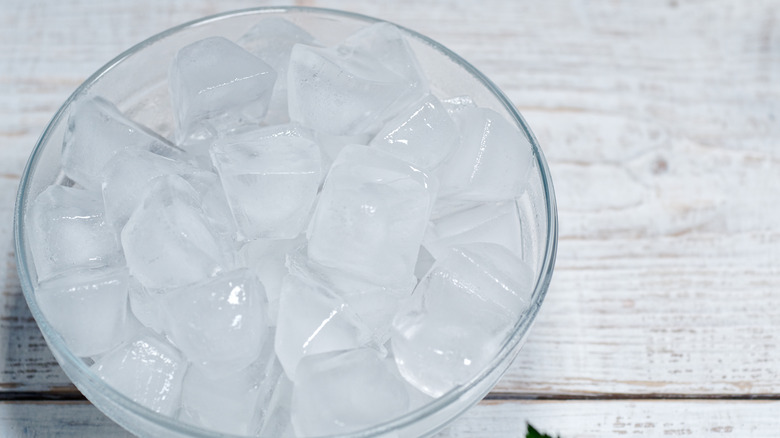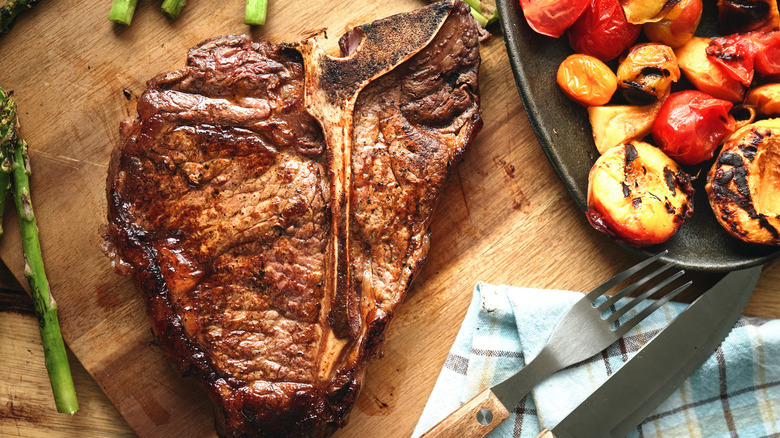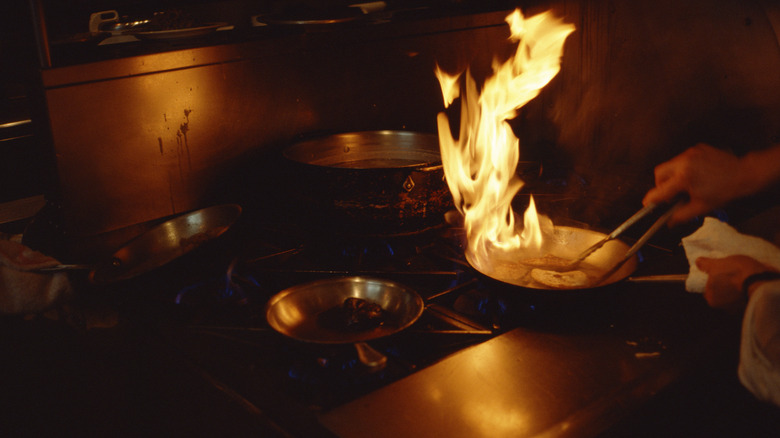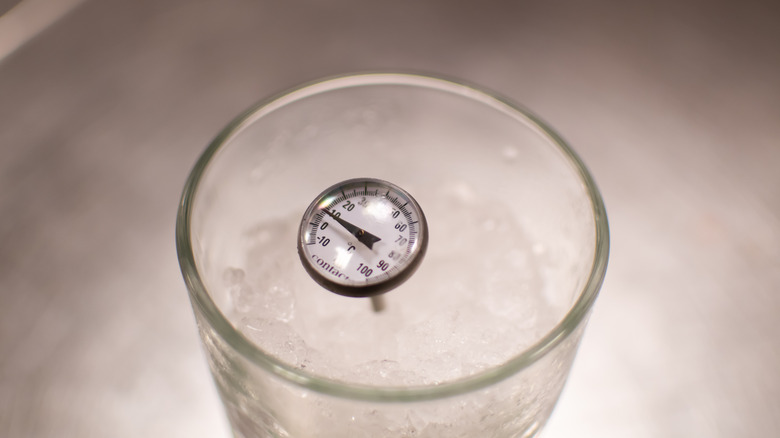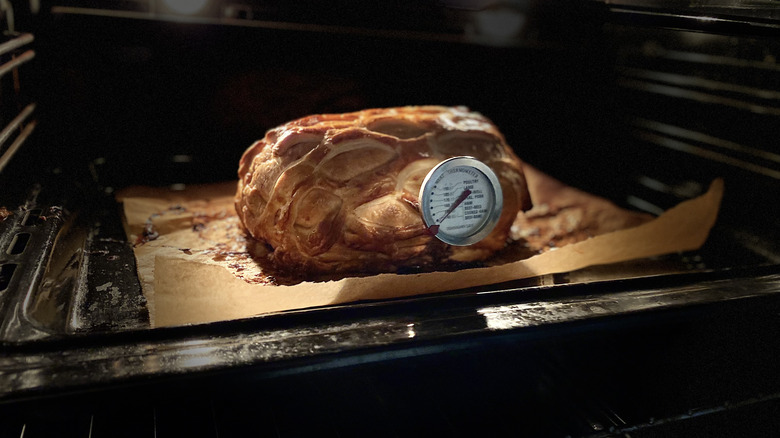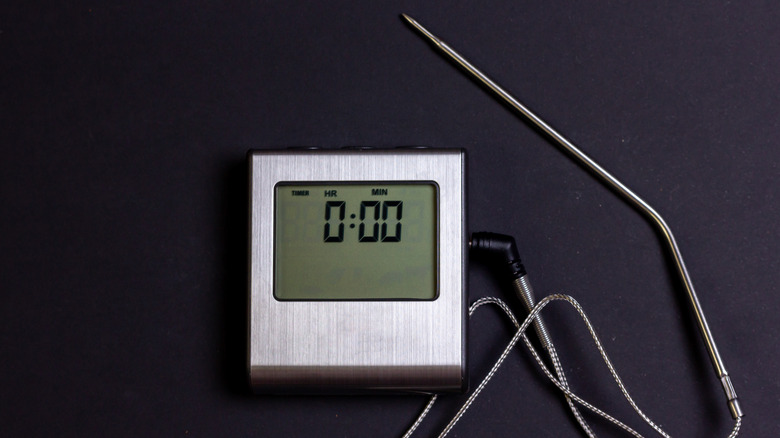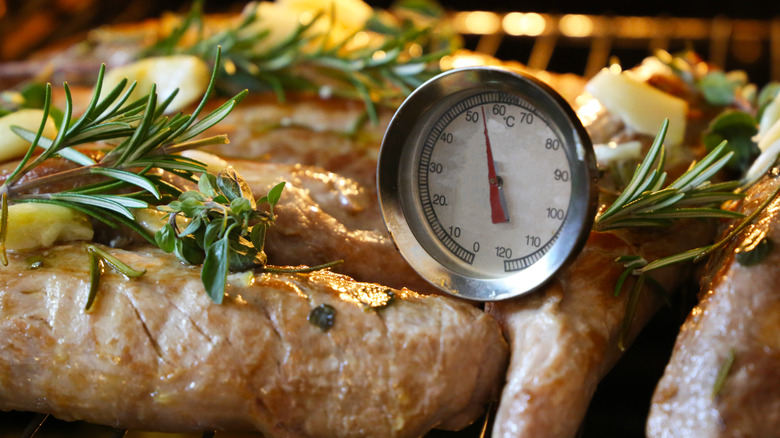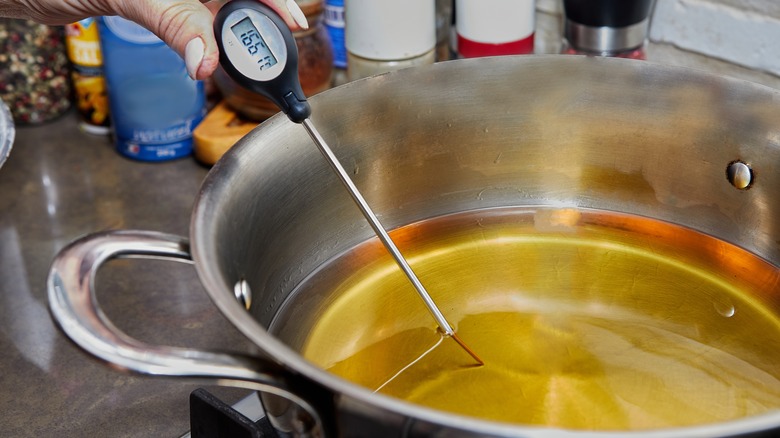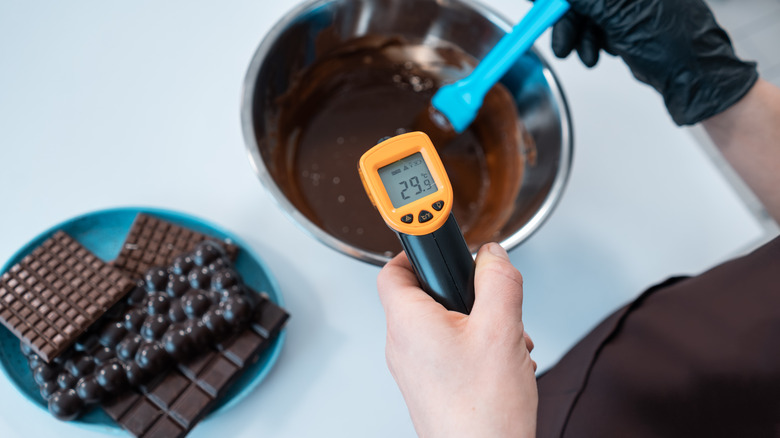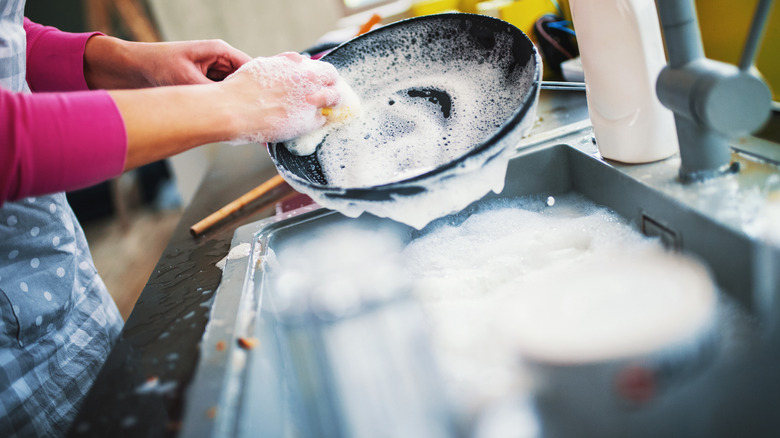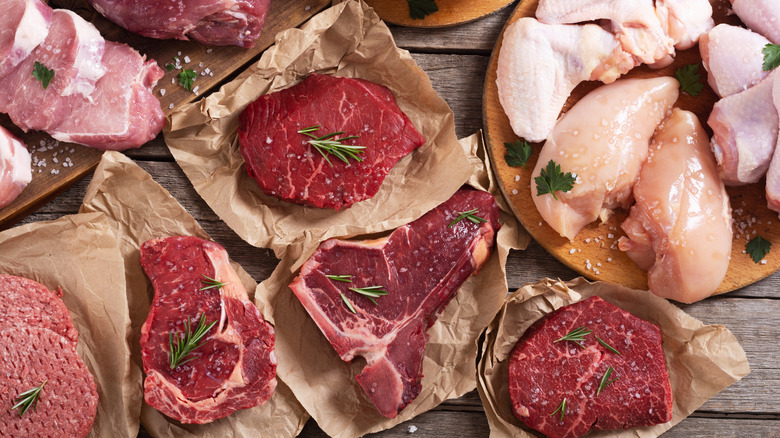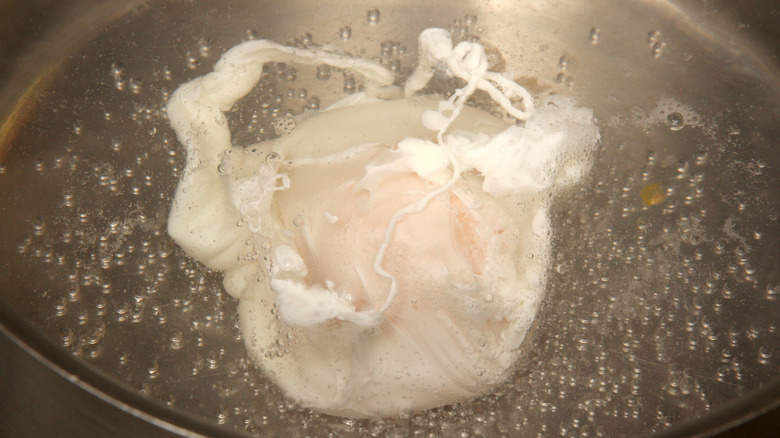Mistakes Everyone Makes When Using A Meat Thermometer
Meat thermometers are compact, affordable, and rarely discussed kitchen tools of meaningful importance. While often overlooked, a meat thermometer is a kitchen sidekick that may help prevent some of the millions of cases of foodborne illness each year. This simple and handy tool may also save your elaborate dinner party from going down in history as the group poisoning of 2023, which is likely different from the impression you want to aim for.
It is crucial for chefs at every experience level to own and properly use a meat thermometer, especially if they ever cook (or plan to cook) beef, chicken, pork, fish, lamb, or any other food that requires a certain internal temperature. Unfortunately, many people misuse and make mistakes with their meat thermometers, leading to potential foodborne illness catastrophes. To ensure you don't become an infamous and feared dinner party host, we hope you can stay with us a bit and absorb the wisdom on how to avoid these common meat thermometer mistakes.
1. Thinking that you don't need a meat thermometer
There is nothing worse than tirelessly planning, shopping for ingredients, cooking, setting the dishware, and serving a glamorous dinner party, for it all to end in miserable ruin. No one wants a lovely evening to result in food poisoning for them or their guests. Even worse would be to find out that their cooking led to salmonella poisoning or something equally as awful. Behold, the heroic meat thermometer enters the scene and saves an otherwise tragic day.
Perhaps you've heard that you can tell a steak is done based on how firm it feels or that chicken, when cooked properly, has no visible pink color remaining. While these tips may be partially true, the USDA Food Safety and Inspection Service suggests that we don't trust those signs alone as indicators of food safety. A meat thermometer is the only foolproof way to ensure a proper internal temperature. Ground beef, for instance, may turn brown, which many people take as an indicator that it's done cooking. The USDA specifies that ground beef can turn brown long before the bacterial pathogens have left the building. Yikes! I doubt anyone wants a side of pathogens with their cheeseburger. So, to be safe, use a meat thermometer, and if you're not familiar with how to do that, don't worry — just keep reading.
2. Only checking your meat once
When using a meat thermometer, be like Santa Claus and check your food's temperature not once but twice, or even more often than that. As you cook a meat dish or other food with a required internal temperature, use your meat thermometer throughout the cooking process to keep track of its progress. The benefits of a meat thermometer include safety, but also the advantage of being able to get your food to exactly the right level of doneness. Say goodbye to dry chicken, overdone steak (a travesty), and boring salmon.
Aim for the second half of the cooking time as a starting point to check the internal temperature. This can be helpful if you're cooking food in an oven, on a stovetop, or even on a grill, and it can help you identify any cool spots or temperature discrepancies in your appliances. So, for the sake of safety, check that meat multiple times. Also, you gain the perk of catering to your guests. Do you want your steak to be a warm pink medium? No problem. Do you want your tuna filet on the rare side? Absolutely. With a meat thermometer, your precise and accurate cooking skills will impress the masses, and you won't make them sick.
3. Not calibrating the thermometer before use
This train is pulling into the calibration station. That's right; we will calibrate our meat thermometers to ensure they won't lead us astray. The entire principle of a meat thermometer helping you cook food to the perfect temperature is thrown out the window if the thermometer isn't properly calibrated to begin with. Thankfully, setting that sucker up and preparing it for action is incredibly easy.
To properly calibrate your meat thermometer, you're going to prepare a simple ice bath. In short, put some ice and water into a bowl. Next, dip the thermometer's end into the ice water, making sure that the tip isn't touching the container, and let it sit while the temperature gauge works magic. The next part, which is very important, is to listen to the song "Ice Ice Baby" by Vanilla Ice or "Cold as Ice" by Foreigner. Once your icy music of choice is over, your thermometer should be ready. If properly calibrated, it should read 32 degrees Fahrenheit (0 degrees Celsius). You're good to go if it reads within two degrees Fahrenheit (one degree Celsius) of the correct temperature. If your thermometer does not give you the proper temperature, let it rest in the ice bath longer until it adjusts. Also, remember that it is important to calibrate your thermometer regularly to make sure it stays on top of its game for you.
4. Sticking the thermometer on bone or in fat
Even the most accurate meat thermometer can be misused, and it's all about location, location, location. When you approach that second half of the cooking time and go to stick the thermometer into your food, make sure not to hit a bone or a patch of fat. Both bone and fat can register at a different temperature than the meat itself and mislead you on how the overall internal temperature progresses. Also, avoid letting the thermometer poke entirely through the meat and touch the cooking pan, as that will register a false reading.
Depending on what you are cooking, there are certain areas to aim for when taking the meat's temperature. Place the thermometer probe midway into the center of the meat for a roast of lamb, pork, or beef. The center is the part that likely will finish cooking last and will give you the most accurate reading. For meat that is thicker in some parts than others, check various points and base completion on the thickest part to ensure a safe internal temperature. For thin foods like a chicken breast or burger patty, insert the thermometer into the side, going through sideways, to achieve contact of the meat to the sensor. Make sure to do this safely, and take the tester piece off the grill or heat source so you don't burn yourself.
5. Forgetting about carryover heat
Carry this knowledge over to your next meal, and remember the concept of carryover heat, also called carryover cooking. This alludes to the fact that foods like meat will continue to cook and rise in temperature even after they have been removed from the heat source. This occurs when you let the meat rest after cooking (which you should always do) and can result in a higher internal temperature than what you initially read before you took it out of the oven or off the grill.
The science behind carryover cooking is thermodynamics, which is a fun, scientific way of saying the wonders of heat in your food. Basically, every food you cook has a certain heat capacity that will change based on how it's cooked, what it's cooked in, and so on. Certain factors can change this, like the shape of the food and how thick the food is. This ties into why the internal temperature matters and gives a smidge of insight into what's happening while you're cooking. Cooking is often tied to science, so consider this your day's science lesson. Yay! If you take nothing else from this science lesson, remember that your meat will cook a little bit more even after you remove it from heat, so plan accordingly.
6. Immersing non-waterproof thermometer versions into water
Earlier, we discussed the importance of calibrating your thermometer in ice water. If you have a head for details, you probably noticed that the instructions are to immerse the thermometer's end in the water. In most cases, you should avoid immersing the entire meat thermometer because not all thermometers are made to be waterproof. Many will completely die if you even get the top of them wet while washing them by hand. Annoying, right? This is where it comes in handy to know what kind of meat thermometer you have and what are its limitations. If you throw your average grocery store-purchased meat thermometer into the dishwasher, chances are you will end up with a useless piece of metal and plastic, which is not ideal.
In the event that you want to measure the temperature of boiling water, you will need a meat thermometer that is resistant to water damage. If yours is not, you need to proceed carefully and keep the top of it safely dry. This is why it is always a good idea to double-check what kind of meat thermometer you have. Airing on the side of caution, you should plan to hand wash your meat thermometers and allow water to only contact the probe or end part that would go into the meat.
7. Leaving a non-oven-safe thermometer in the oven while cooking
You've probably seen those charming Thanksgiving commercials where a turkey is roasting in the oven with a thermometer sticking out of it. This is a great way to measure the cooking temperature of a turkey, for instance, if the meat thermometer is made to be "oven safe," which not all of them are. When in doubt, find out. The thermometer's packaging should tell you if it is an oven-safe version or not and provide basic safety information. If you have a hand-me-down thermometer and don't know, you can always reach out to the manufacturer to ask.
Oven-safe meat thermometers are designed to withstand higher temperatures than the kind that you stick in and remove. Typically, the oven-safe options will have a physical dial inside of its glass that moves gradually like a thermometer. Digital meat thermometers can also be designed to be oven safe and can actually be very helpful. Some involve a probe that you stick into the meat at the end of a wire. The end of the wire goes outside of the oven to a device that, in some cases, will beep when the meat reaches the desired, programmed temperature. Pretty nifty.
8. Not comparing the different types of meat thermometers
In addition to oven-safe versus non-oven-safe meat thermometers, the design and features of meat thermometers can vary, depending on how high-tech you want your kitchen gadgets to be. If you find yourself shopping for a new meat thermometer (after being inspired by this persuasive article), feel free to shop around and explore your different options.
Among the meat thermometer options, there are thermocouples, thermistors, oven cord thermometers, thermometer-fork combinations, bimetallic-coil thermometers, "oven-safe" coil thermometers, single-use gadgets, pop-up timers, and "instant read" thermometers. Whew. There are also liquid-filled options, oven-only thermometers, and pretty much anything else you can imagine. If you're a grill master, maybe you want one that is catered to grilling. If you're more of an indoor cook, you can compare digital versus not digital and select from among instant-read, leave-in, and even disposable thermometers to find what speaks to you. The moral of the story is the meat thermometer market is your oyster.
9. Being unaware of the proper internal temperature of different meats
The most important thing about cooking with a meat thermometer is, unsurprisingly, the internal temperature of whatever it is that you're cooking. So, let's go over some basic internal temperature guidelines and best practices. For chicken, the minimum number to aim for, with safety in mind, is 165 degrees Fahrenheit. Ideally, cook chicken breast meat up to 170 degrees Fahrenheit and dark meat (like thigh meat) up to a temperature of 180 degrees Fahrenheit. The temperature for beef will vary based on the preferred finish, but the safe temperature to avoid the risk of foodborne illness is 145 degrees Fahrenheit.
Other foods like ground meats, lamb, pork, and veal range between 145 degrees Fahrenheit and 170 degrees Fahrenheit, so remember to research the proper temperature for the meat or dish that you plan to cook. While many recipes may suggest lower temperatures for preferred doneness, it is advisable to prioritize safety and abide by these basic minimum temperatures. Thankfully, there are plenty of helpful resources and temperature charts online in case you forget or need a reminder.
10. Forgetting that it can also be used for oil
Meat thermometers are not just for meat and can serve as a helpful staple for other dishes as well. One such task is measuring the temperature of oils. This is especially important when frying food, as the temperature of oil will ultimately dictate the temperature of your food. The finished product can be ruined if the oil is too hot or too cold. Luckily, a meat thermometer can help you avoid any fried food fury.
To check the temperature of the frying oil before inserting your food, put the meat thermometer's probe into the oil, and allow it to remain long enough for an accurate reading. As long as the result falls within one to two degrees of your desired temperature, you should be safe to proceed with adding in the food that will be fried. The good news is that you don't need a special thermometer to measure oil. For the occasional frying endeavor, your typical digital, instant-read thermometer will do the trick perfectly well. If you plan to become a frying fiend, it may be worth investing in a more specific thermometer that can sit in the oil for longer periods of time.
11. Thinking that meat and candy thermometers are the same thing
It is important to remember that not all culinary thermometers are made equally. For instance, while you can use a meat thermometer to measure the temperature of oil, a meat thermometer does not replace a candy thermometer and should not be used in the same way. While some bloggers may refer to the two as synonymous, a meat thermometer and a candy thermometer are not interchangeable.
Meat thermometers typically have a temperature range of up to 200 degrees Fahrenheit, whereas candy thermometers can reach levels of up to 400 degrees Fahrenheit or more. That difference of 200 degrees is quite relevant, as the process of cooking candy involves temperatures much higher than the boiling temperature of the water, which can damage a standard meat thermometer. Another distinguishing factor between the two is the length of the thermometer's probe. While meat thermometers are relatively short, candy thermometers are often longer, which allows for them to rest upright in a pot of boiling sugar, for instance.
12. Not sanitizing your thermometer properly after each use
Considering the main point of using a meat thermometer is to ensure safety while cooking, we must remember the importance of sanitization. When you test food with a meat thermometer, it is likely to make contact with meat that isn't fully cooked and that may still harbor some unfriendly pathogens. Therefore, it is crucial to clean your meat thermometer after each use.
While remaining mindful of your thermometer's waterproof status, there are a few ways to clean and sanitize your helpful cooking buddy effectively. A straightforward option is to wash it by hand in hot water with antibacterial dish soap. You can also use alcohol wipes, white vinegar, a dip into boiling water, or a wipe-down with an alcohol swab. If you use a product with alcohol, just make sure to give it a rinse afterward so that you don't contaminate your food with the taste of chemicals. After that, your meat thermometer should be clean, fresh, and ready to help with your next meal.
13. Testing the temperature of raw meat
With safety at the forefront of priorities, your meat thermometer should only be used to check meat that has been mostly cooked. Earlier, we discussed checking the internal temperature toward the second half of cooking. This is because you do not want to jab your thermometer into raw, potentially unsafe meat that could later contaminate your cooked food. However, if you do check the temperature too soon and your food registers a super low temperature, don't worry. Simply sanitize the thermometer before the next temperature test to make sure none of the potential bacteria ruins your otherwise lovely meal.
The same rule applies to other things that have made contact with raw meat. If you used a cutting board or knife to prep your raw meat, immediately stash those germy things in the sink so you won't be tempted to use them later. If you used a marinade to season your raw meat, throw it away once your meat has been removed. Even if it has lots of lovely spices and juices in it, the marinade may still contain the same scary stuff that was in the raw meat. By reintroducing that yuck onto your cooked meat, you could undo all of your conscientious, safety-minded progress, and we want to avoid that. After all, you are on your way to being a safe cooking expert.
14. Forgetting about other household applications
Meat thermometers are truly invaluable kitchen staples that not only ensure safety but provide peace of mind while cooking. Meat thermometers can also be used for more than just meat. Your handy dandy meat thermometer can be a helpful gauge to test the temperature of boiling water, which can guide you in achieving the perfect poached eggs. This also ensures the eggs get to a proper internal temperature to kill off any bacteria since salmonella is a scary fiend.
Other uses for your meat thermometer include checking the temperature of oil for frying or even for checking the temperature of baby formula. To really get the maximum bang for your buck and expand its use beyond the kitchen, you can also use your meat thermometer to check the temperature of bath water. How inventive, right? Truly, a meat thermometer is a helpful and multipurpose tool for various household tasks.
